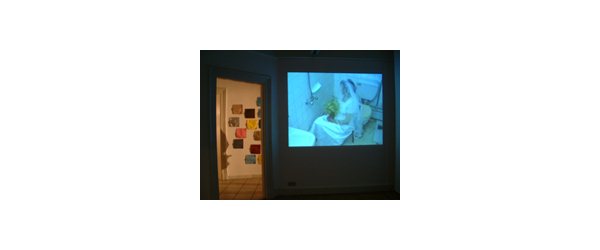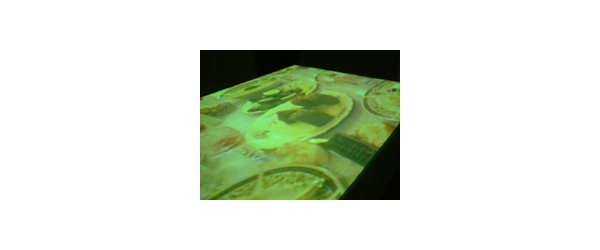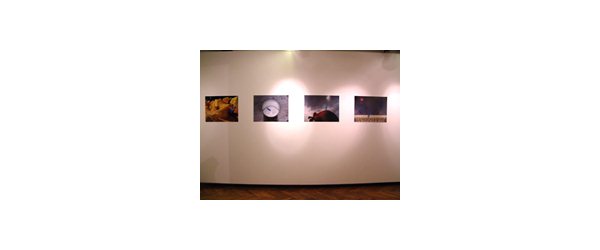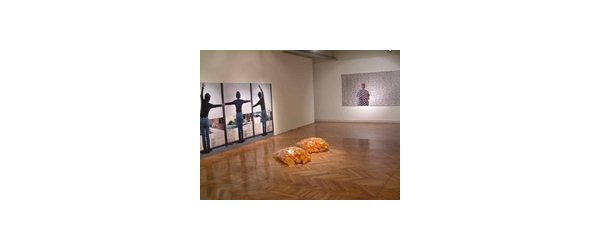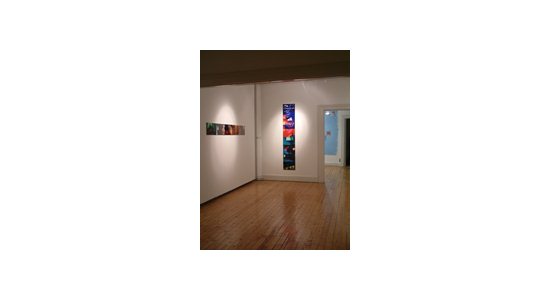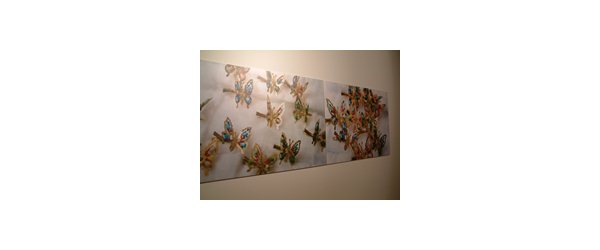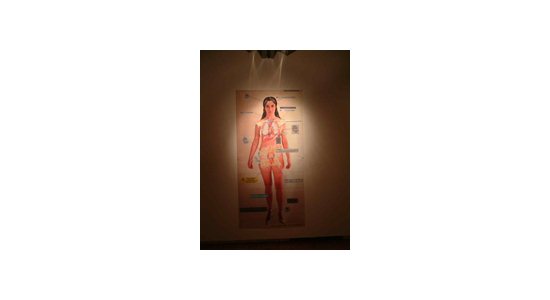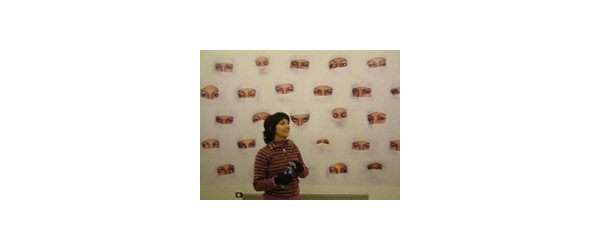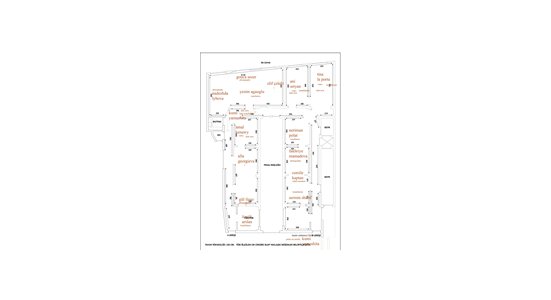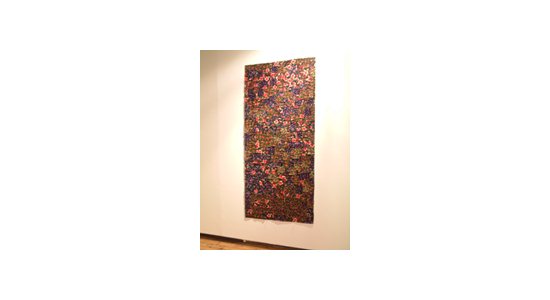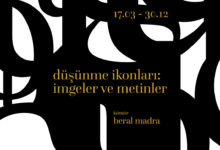sphinx will devour you
sfenks seni yiyip yutacak
SFENKS SENİ YİYİP YUTACAK
THE SPHINX WILL DEVOUR YOU
Onbeş Kadın Sanatçı’dan resim, fotograf, dijital baskı, video ve yerleştirmeler
Fifteen Women Artists in painting, photography, digital print, video, installations
15 Mart/March-7 Nisan/April 2004
Karşı Sanat Galerisi (Elhamra Pasajı)
Yeşim Agaoglu / Özgül Arslan / Elif Çelebi / Alla Georgieva (Sofia) Gül Ilgaz / Cemile Kaptan / Amel Kennawy (Cairo)/ Nadezda Oleg Lyahova (Sofia)/ Fakhriyya Mammadova (Baku)/ Neriman Polat / Tina La Porta (New York) / Ani Setyan / Sermin Sherif /Gonca Sezer Kumi Yamashita (Tokio)
küratör/curator: Beral Madra
koordinasyon ve halkla ilişkiler/coordination and PR: Nilüfer Sülüner
80’li yılların ortasından bu yana Türkiye’li kadın sanatçılar atılgan, dikkat çekici ve irdeleyici işler üretiyor ve uluslararası ortamlarda ilgi görüyor. Yine de kuram ve uygulamada modern ve post-modern sanat içinde erkekegemen söylemin gücü yadsınamaz. Türkiye’nin post-modernlik sürecindeki geçişlerde kadınlar hala sürmekte olan geleneksel yapılar yüzünden siyasal, ekonomik ve toplumsal alandaki kimliklerini kabul ettirmek için uğraş veriyor.
Post-modernlik süreci kadınlar için bir açılım oldu; ama status quoyu değiştirmek öyle kolay bir iş değil. Toplumun dışına atılmış ya da toplumdaki kimliği bastırılmış bireylerin – ki bunlar içinde her sınıftan ve her meslekten kadınlar çoğunluktadır – durumunu iyileştirmek için herşeyden önce geçerliğini yitirmiş ve kalıplaşmış değerlerin yıkılması ve kitlelerin ve kurumların modernist bakışını ve yapısının kökten değişmesi gerekiyor. Bu bağlamda günümüz sanatının sorgulayıcı, irdeleyici ve sarsıcı örnekleri önemli bir işlev taşırken, kadın sanatçıların bu üretim içinde yansıttıkları paylaşımcı, iletişimci, esnek ve işbirlikçi nitelikleri yararlı sonuçlar doğuruyor.
Türkiye’deki bugünkü “kadın manzarası” karmaşık, bulanık ve konumuna göre de ürkütücüdür. Onüç yaşındaki çocukların “kirlenmiş kadın” olarak damgalanıp öldürüldükleri, tinsel ve anlaksal olarak gelişmemiş, eğitilmemiş genç kızların TV ekranlarında sömürülüp söndürüldükleri, simsiyah çarşaflara bürünmüş “yüzsüz” ve “gövdesiz” kadınların köle/cariye olarak kullanıldıkları, aydın ve çalışan kadınların toplum, aile ve özel yaşam içindeki yerinin ve kimliğinin erkek egemen tartışmalar içinde yitirildiği bir ortamda yaşıyoruz. Bu ortamda kadınlar siyasette, ekonomide ve kültürde kendilerine öngörülen, biçilen ve izin verilen konumlarda yerlerini alıyorlar ve zaman zaman seslerini duyurup istediklerini elde edebiliyorlar. Kadınlar kendi aralarındaki rekabet alanlarını da beklendiği gibi, ama çoğu zaman yine erkek egemen söyleme hizmet ederek dolduruyorlar.
Serginin başlığı, bu koşullar içinde kadının kimliği ve durumu ile ilgili bir irdelemedir.
Sfenks, Ödipus efsanesindeki trajik figürlerden birisidir. Ödipus Delphoi’de tanrı bilicisinden anasını ve babasını öldüreceğini öğrendikten sonra Korinthos’a bir daha dönmemeye karar verip Thebai’ye varır. Thebai kapısını bekleyen, yüzü ve gögüsleri kadın, gövdesi aslan olan canavar, sorduğu bilmeceleri bilmeyenleri parçalıyıp yemektedir. Sfenks şu soruyu sorar: Tek sesi olan, kimi zaman iki, kimi zaman üç, kimi zaman dört ayak üstünde yürüyen ve en çok ayağı olduğu zaman en güçsüz olan yaratık hangisidir? Oidipus “insan” diyerek doğru yanıtı verir ve Sfenks kendini durduğu yükseklikten uçuruma atarak ölür. Ödipus kıral Kreon’un vaad ettiği gibi Thebai kıralı olur.
Bu başlığı taşıyan sergi, 80 yıllık geçmişi olan modernist ve laik devrime karşın, içinde yaşadığımız dönemde toplumun “kadın manzarası”ndaki çarpıklığın, krizlerin, karmaşanın boyutlarını ne kadar gündeme ve ciddiye aldığının sorgulandıgı bir alan olmaya talip.
Beral Madra/ Şubat 2004
*************************************************************************
A sphinx is half woman-half lion with breasts and wings. When we look up the definition of sphinx, it means “to strangle, guard; gatekeeper or protect”. Paradoxal terms unified in one image!
The sphinx is a grecian myth and since ages, is a major part of masonry which is a male secret society.
According to the greeks, the sphinx was a guardian of the city of Thebes. She sat on a cliff infront of the gates leading to the city. Anyone that wanted to enter Thebes had to first confront the sphinx. The sphinx would ask one simple riddle and if the person didn’t know the answer, she would devour him, tearing him to pieces. The king, Creon, was troubled that many people were unable to enter his city. He consulted Oedipus and offered his crown and his daughter if he could kill the sphinx. So he confronted the sphinx who asked him the riddle, “What has one voice, and goes on four feet on two feet and on three, but the more feet it goes on the weaker it be?” Oedipus responded, “Man — who crawls on all fours as a baby, then walks on two as an adult, and walks with a cane in old age.” After answering the riddle correctly, the sphinx committed suicide, jumping off the cliff and Oedipus was claimed king of Thebes.
Symbolically, the body signifies the animal nature, which exists in women in the form of the lion, which is the royalty, and power of the divine spirit that has been myth logically attributed to women as mother goddess. The riddle represents the knowledge and intelligence inherent in women. Metaphorically speaking, the sphinx coveys its knowledge and intelligence to men by destroying its lower animal nature and bestows him the refinement of the thought process that leads to the spiritual evolution of man. By solving the riddle, Oedipus (the man) became master problem-solver.
The Sphinx is one of the most striking monuments of the ancient Egyptians, and has attracted the attention of travellers, scientists, archaeologists and others for generations. The Sphinx had a philosophical impact on the ancient world, on Arab writers, on Renaissance travellers, on the pioneers of Egyptology and on modern scholarship and theory.
This episode in Oedipus’s mythology is the turning point in Oedipus’s fate which lead him to kill his father and sleep with his mother. Freud describes the source of this complex in his Introductory Lectures (Twenty-First Lecture):
“You all know the Greek legend of King Oedipus, who was destined by fate to kill his father and take his mother to wife, who did everything possible to escape the oracle’s decree and punished himself by blinding when he learned that he had none the less unwittingly committed both these crimes.”
To explain the early psychodrama of your childhood, Freud turned to a dramatic work, Sophocles’ Oedipus Rex, in which Oedipus attempts to escape his fate. However, in the process, where the confrontation with the sphinx is the key event, he unintentionally does the very things he was attempting to avoid. Freud therefore invented the term Oedipus Complex.
Lacan – the successor of Freud – has developed his Mirror Stage on the Oedipus complex. Within his famous theories “the women does not exist” fits in to the context of the title “the sphinx will devour you”. Slavoj Jijek says in his interpretation of this theory: “Existence” is a linguistic term, it means things, which can be referred to, and this is the opposite of Lacan’s concept of “the real”, which is the unspeakable. So, what exists is only what linguistically gets “represented”, or, more accurately, referenced. If it is not mentioned, or cannot be mentioned, it does not exist. Likewise, enjoyment is necessarily dumb. Therefore, “the woman” cannot exist in language. Why? Well, Lacan is trying to simply describe a situation neutrally, and he describes a patriarchy dominated world where women don’t get into language, thus do not exist”.
We know that in non-democratic, semi-democratic as well as democratic societies the gender ideologies and relations are based into two clear-cut groups, women and men, where in most societies men absolutely dominate the women, giving no room for choice, difference and resistance. Judith Butler’s preference of transformation of historical and anthropological positions that understand gender as a relation among socially constituted subjects in specifiable contexts’ has not happened yet. Quoting her words, there are still fixed attributes in a person, gender is not yet a fluid variable which shifts and changes in different contexts and at different times.
One of the most hegemonic fields within this context is the media, which disseminates alternative images and places the women to the center of the war of symbols as the defeated subject. We”are in the age of the electronic media,as signifier of the male gaze and ego.
Butler showed that “gender is not just a social construct, but rather a kind of performance, a show we put on, a set of signs we wear, as costume or disguise”. Within the neocapitalist “lifestyle” discourse the performance/show of women is a substance for pure commodity.
She indicated that in Western discourse, “woman” is always the other of “man”, hence excluded from culture or the Symbolic and in feminist theory, “woman” is universal category, which thus excludes differences of race, class, or sexuality. In fundamentalist Islamic societies, the woman is not even “the other”, she is the simple tool of ideology. Accordingly, the feminist theory in non- and semi-democratic countries became an extension of male dominated state policy.
This leaves the majority of the society no way but to think about women as fragmentations and disjointed subjects.
As to the riddle, with its classification of childhood, youth and old age, it also represents the fate of human hood shifting from dependence (crawling) to independence (walking) and back to dependent status (walking with a cane) it really relates us to the main conflict in neoliberal capitalism today. In our societies there are those who produce and those who do not or cannot. The ones who produce are rewarded with a welfare life and the rest are left to poverty and deprivation; among these children and women are the ones who most of the time suffer.
In the age of electronic images we are predisposed to perceive and face the world in fictions and fictional representations. We are obliged to identify “the self” in images. Art in its resistant forms seems to be the only juxtaposition to the media, electronic images and male hegemony. The people are also contented with the representations in paintings and other forms of art, where they can see definite significations and cohesive subjects – even if the representations reflect the uncanny, the abject, the transgressive. In our struggle for coherence, art forms help us to imagine the undivided subject. The art became a realm in which we are reassured that there are integrated subjects within this world.
Beral Madra / February 2004




